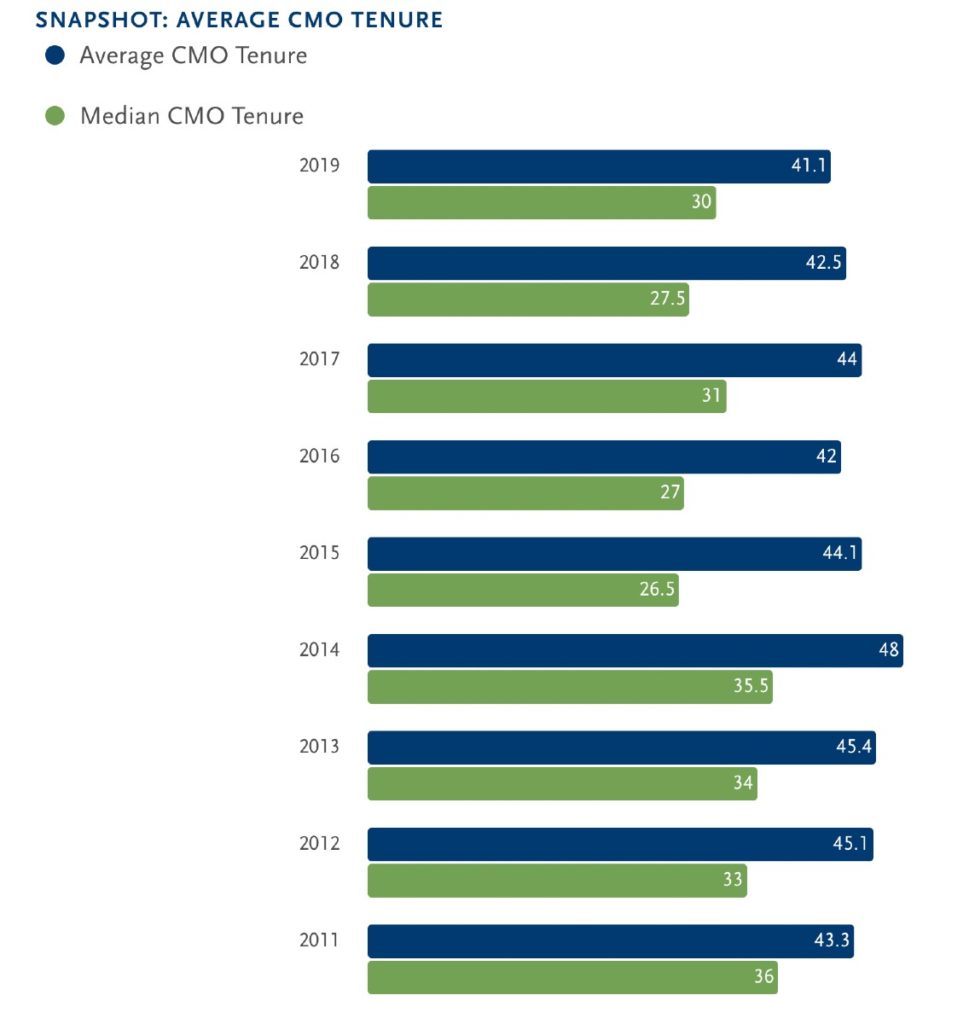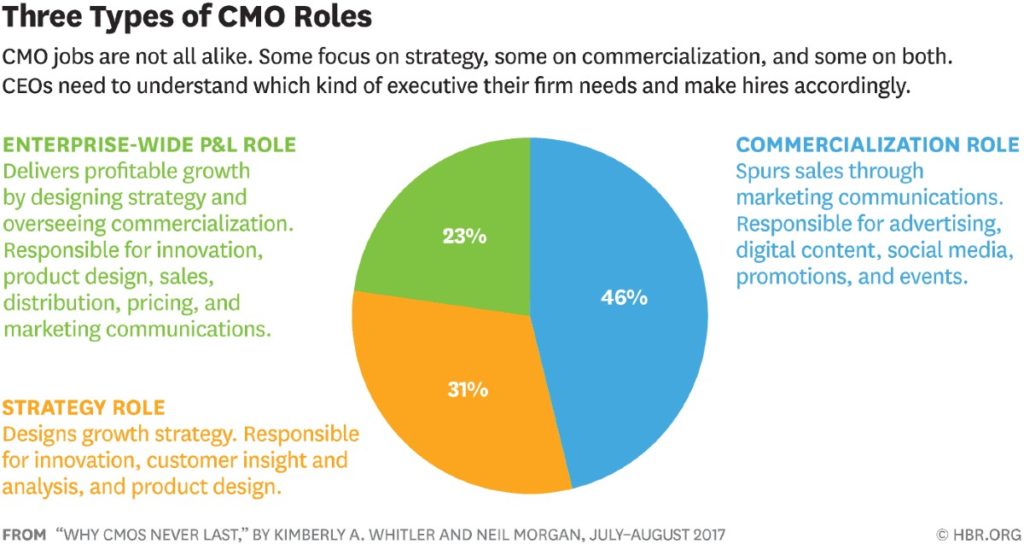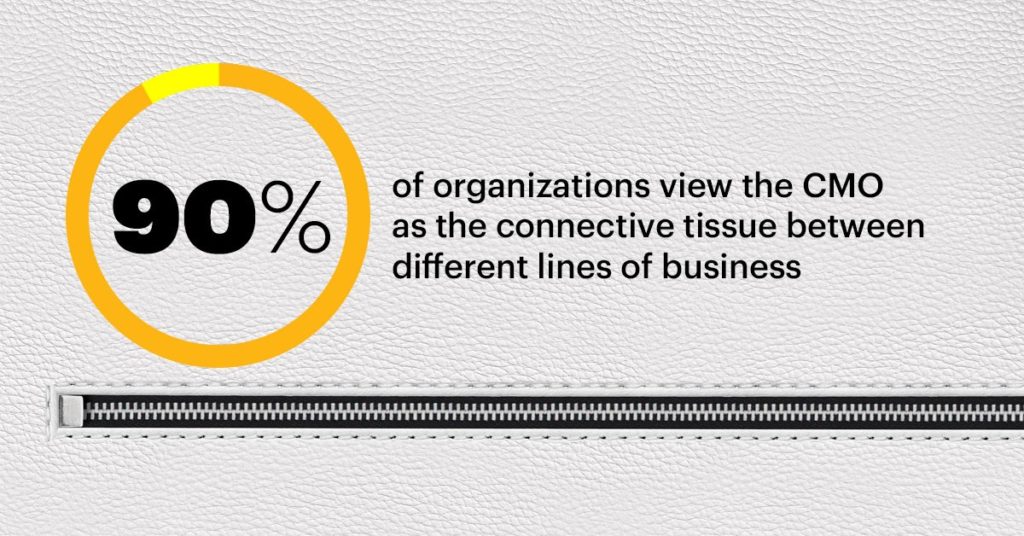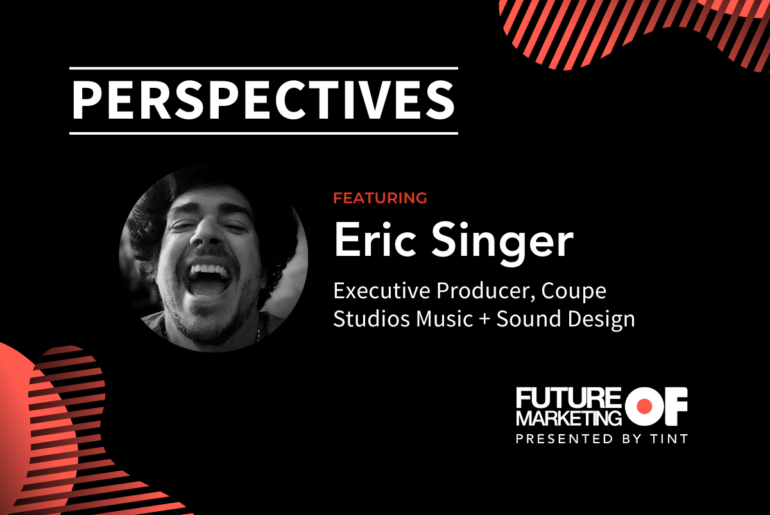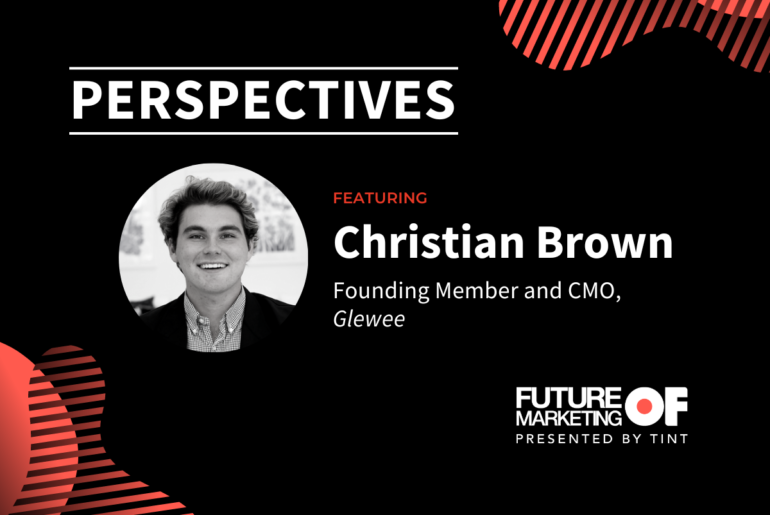Amid many challenging C-Suite roles, the CMO role is perhaps the most complex.
Research firm Spencer Stuart reported the median tenure of a Chief Marketing Officer was 41 months in 2019 (slightly over three years) while in 2017, Korn Ferry shared the average CMO in the consumer industry stays 3.6 years – the lowest tenure of all C-suite roles.
“The new number is the lowest that we’ve seen since 2009,” shared Greg Welch with Spencer Stuart.
One reason for churn is that many senior marketers believe stakeholders don’t fully understand the value and complexity of their work. In fact, a survey conducted by Forbes uncovered 54% of company leaders feel their companies’ marketing and business strategies were misaligned.
“Yesterday’s CMO was about communications, branding, and advertising. Today, the CMO is a strategic partner to the CEO, someone expected to understand the business landscape well enough to articulate and predict which markets, products, services, or execution strategies will deliver the most profitable growth,” shares The Evolved CMO.
When approached intelligently (and patiently), marketing can be a high-revenue generator that separates ‘fluff’ from tactics that actively impact the bottom line.
The future promises additional complexity when it comes to the role of CMO. There is an increasing expectation from marketers to be, both, left- and right-brain thinkers, quantitative and qualitative researchers, business-savvy, yet creative. A skill that is challenging to master, but powerful when achieved.
“The CMO of the future will need to have people management skills and needs to be stronger in strategy and all the things about where to play, and how to seek competitive advantage,” said Jim Stengel, former CMO of Procter & Gamble. “They also need to be able to recognize and find strong partners. This individual will be very skilled in analytics and very good at basic research and curiosity. CMOs need to spend less time in making ads, running projects, and managing agencies and instead ramp up in these other areas.”
Expectations for senior marketers (especially in small teams) continue to rise in terms of what they know and can do. Marketers are expected to be entrepreneurial, brand strategists, creative thinkers, doers, consumer psychologists, designers, content writers, editors, data analysts, art directors, publicists, web designers, social media managers, event planners, community builders, lead generators, growth hackers.
The list goes on.
No CMO role is the same. Adobe shares, “Unlike other company functions, marketing has grown to encompass multiple specialties, touching everything internal and external, from prospects and customers to employees and investors.”
Commercialization, growth strategy, and communications are all different, for instance. Commercialization encompasses communications. The growth strategist focuses on customers and innovation. And about a quarter of CMOs take on both roles – which can obscure focus without a clear strategy.
“CEOs need to understand which kind of executive their firm needs and makes hires accordingly,” states Harvard Review. “We believe that a great deal of CMO turnover stems from poor job design. Any company can make a bad hire, but when responsibilities, expectations, and performance measures are not aligned and realistic, it sets a CMO up to fail.”
Finding a CMO who can encompass all roles in one is like finding a unicorn. Great CMOs possess enough know-how to be dangerous across multiple disciplines, but the best marketers double-down on their strengths, build teams that complement their weaknesses, and communicate purpose across the board.
Communicates ‘why’
Aligning stakeholder goals to the sales, customer success, and marketing teams (among others) is easier said than done. Part of a CMOs responsibility is to identify what needs to be accomplished (or pushed aside) for the brand to succeed. CMOs must align and communicate brand value internally and externally, craft a story, and ensure brand tactics aren’t merely producing noise.
Strategy is often more about saying ‘no’ than it is ‘yes.’ It is about focusing on the most effective approach despite all available options. It means delivering quality holistically and understanding what a brand needs to communicate, to whom, how – and why should the desired audience care in the first place.
“My advice to CMOs of the future is to define the role of marketing within the organization,” shares Jim Stengel, former CMO of Procter & Gamble. “Ask yourself what is the work you want to do and what you need to do it. Beyond that, CMOs of the future should develop and share and get feedback on their philosophy and how they do marketing.”
Business strategy drives brand strategy, which influences marketing strategies. This is usually challenging to communicate, as many CMOs are expected to build and offer experiences before a blueprint or budget even exists.
Aligns metrics with expectations
A great CMO will always be thinking about how they can improve the bottom line of the business. Yet, most CMOs aren’t given the authority to accomplish what is expected of them in the first place.
A study by Deloitte reports only six percent of CMOs feel they are actively working on growing revenue across all global business activities – while 95 percent of respondents said revenue is the priority measure of growth in the organization.
When approached strategically, marketing impacts ROI. However, 80% of CEOs don’t trust or are unimpressed with their CMOs – compared to 10% with CFOs. In fact, 74% of surveyed CMOs say their jobs don’t allow them to maximize their impact on the business – yet, some stakeholders expect results without clarifying business goals. This can account for the large churn in the CMO role, as activity needs to link back to a revenue figure – setting a CMO up to fail or be replaced.
Instead of limiting a marketing team’s impact on external factors – like advertising and communication – CEOs need to give CMOs the ability to start internally. Similarly, CMOs must regain the trust of CEOs by understanding the high-level needs of the business – and repositioning their role from the inside-out.
Does the CEO need growth strategies? Or are strategies available, and the business needs someone to focus on advertising and communicating these strategies?
Builds brand trust and perception
From the way you look to the way you speak and function – a strong brand pulls people in and generates trust. It is what drives people to trust and feel good about what you offer.
Marketing, on the other hand, is what pushes your brand and message out. It makes the ‘brand’ run. As Marty Neumeier, author of The Brand Gap wrote, a brand is a ‘gut’ feeling; it is people’s perception of you, your product, or organization. It is the first impression.
Marketing fuels that impression (whether it’s good or bad).
CMOs of the future will place heavy emphasis on improving the perception and experience people have with brands – before the marketing phase. When your marketing team pushes out ads implying you have ‘the best brand on the market’ – it will be expected.
And if your brand doesn’t deliver on that expectation, it impacts people’s perception of your brand.
It only takes seven seconds to make a first impression. In fact, “Buyers make most decisions by relying on their two-second first impressions based on stored memories, images, and feelings,” shares Malcolm Gladwell in Blink: The Power of Thinking Without Thinking.
Every touchpoint impacts how people perceive and feel about your brand – from the moment someone lands on your social media profile to the moment they visit your website, engage with your content, download your product, and so forth. However, people will not bother moving forward to the next touchpoint if the first impression doesn’t look credible or enticing enough to proceed.
The pandemic, for instance, has shifted brands and consumers to social media platforms, making this a ‘hot spot’ for attracting new people in real-time. Now, CMOs are stepping back to reposition and strengthen brands to develop more user-centric experiences.
When CMOs look at user journeys, they should also seek how effective and profitable the new journey is. Can it be cheaper and more effective? Can it link back to attribution easily? In more than a few cases, the CMO is reporting to the board and shareholders, so bottom-line effectiveness and impact should, both, be top of mind for the CMO.
Team-, customer-, and experience-centric
The best brands make you feel like they are a part of something special – from start to finish. They don’t simply sell a product. The best brands feel relatable. Exciting. Inspiring. Essential. And they drive word-of-mouth.
Customers need to feel like there isn’t a better alternative for your brand – but ‘smart’ marketing begins with understanding the goals of a business.
According to an Accenture global research study, “The CMO Collaborator must now step up and govern how customer experiences are shaped and delivered organization-wide. To deliver world-class experiences a requirement of unparalleled collaboration is needed across the organization and the CMO is seen as the connective tissue between different lines of business by 90 percent of organizations.”
Understanding how each department impacts the other – what product teams are working on, what is generating the most and least revenue, what customers need – is key to moving in the right direction and synergizing needs to connect the customer journey to the brand.
Omnichannel vision
In today’s age, social media is the frontline of your business.
As social media usage and competition surge, brands are using user-generated content to drive trust, develop closer relationships, and influence their audience to do what they need them to do.
“It’s not enough to have mastery over a single technological domain,” shares Core DNA’s CEO.
“As a CMO, you need to have expertise across multiple channels. Get comfortable with Twitter, Pinterest, and YouTube while also taking the time to study how consumers use gaming consoles to browse the web.”
Simply put, if a marketing channel exists, CMOs should know it inside out. They should also understand how communication platforms are transforming, the demographics and psychographics within each channel, and the content people are most receptive to – and why.
Montse Passolas, global CMO at GHDXX shares, “We used to buy space on TV or in a magazine. Now we work with these great, enthusiastic content creators who add a personal touch to our brand.”
CMO of the Future
The CMO role will become even more complex. In the near future, business results will be driven by agile, multidisciplinary CMOs who possess the right hybrid of business acumen, creativity, communication skills, team-building, focus – and adaptability. Additionally, the CMO will be someone who implements robust technology stacks to future proof digital elements of the CMO tool kit.
“The big shift happening for marketing is moving it from a cost center to a revenue generator,” states Giselle Abramovich, Senior Editor for Adobe CMO. “Marketing will no longer be that fuzzy activity many others in the corporate structure view as fluff.”
Are there high expectations for CMOs? Absolutely.
But for a CMO to succeed in the first place, CEOs should understand and clearly articulate business needs to get the right CMO skillset on board – allowing senior marketers to express what they would do if they were steering the ship. Ultimately, CMOs need the support of the organization to realize full impact potential.
The future of the CMO role will be like having a co-founder to build with. It will be more collaborative. Strategic. And experiential.
If you enjoyed reading this article, consider subscribing to our weekly newsletter here – where we uncover marketing insights, resources, and social media strategies around the globe.

